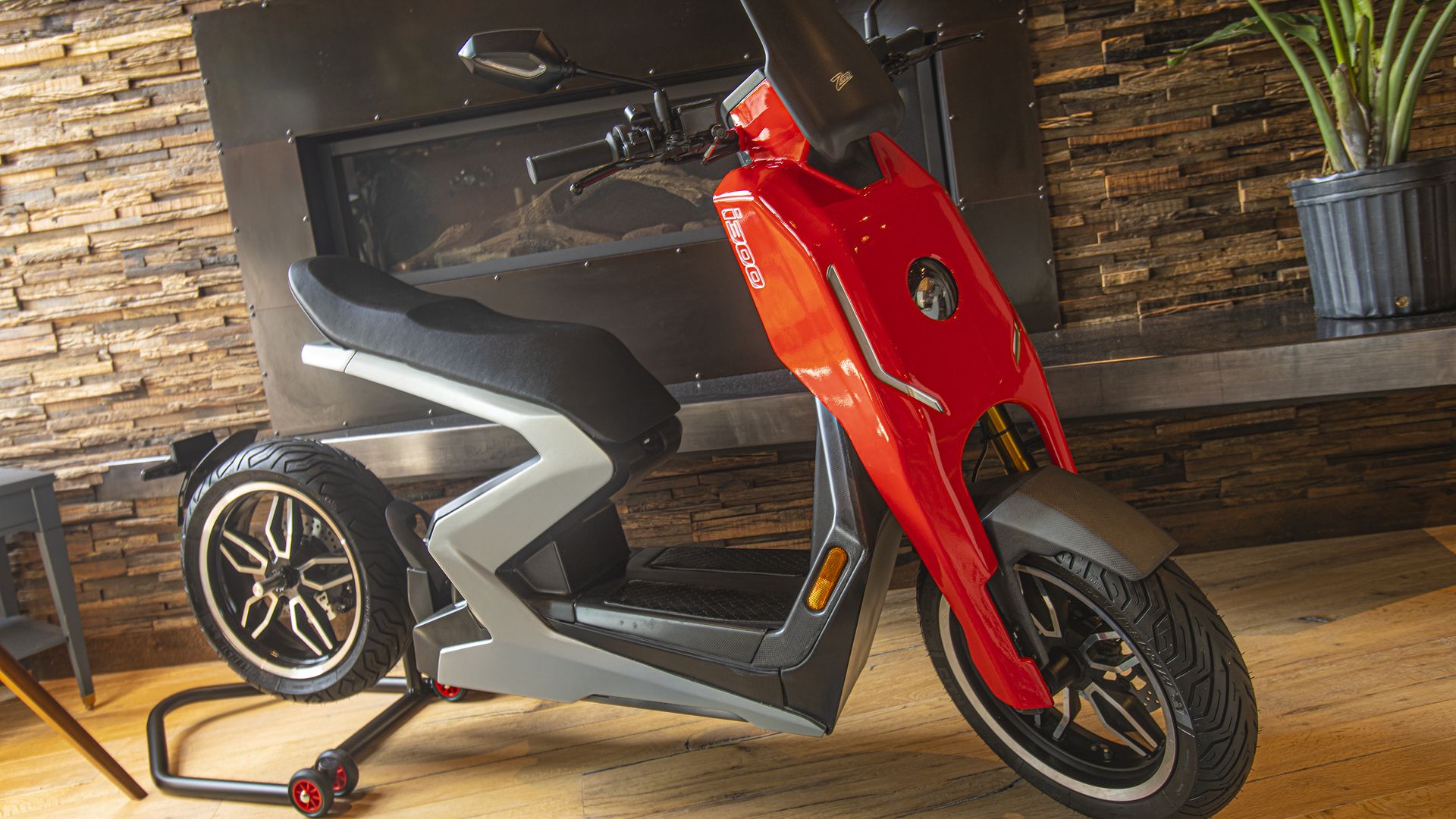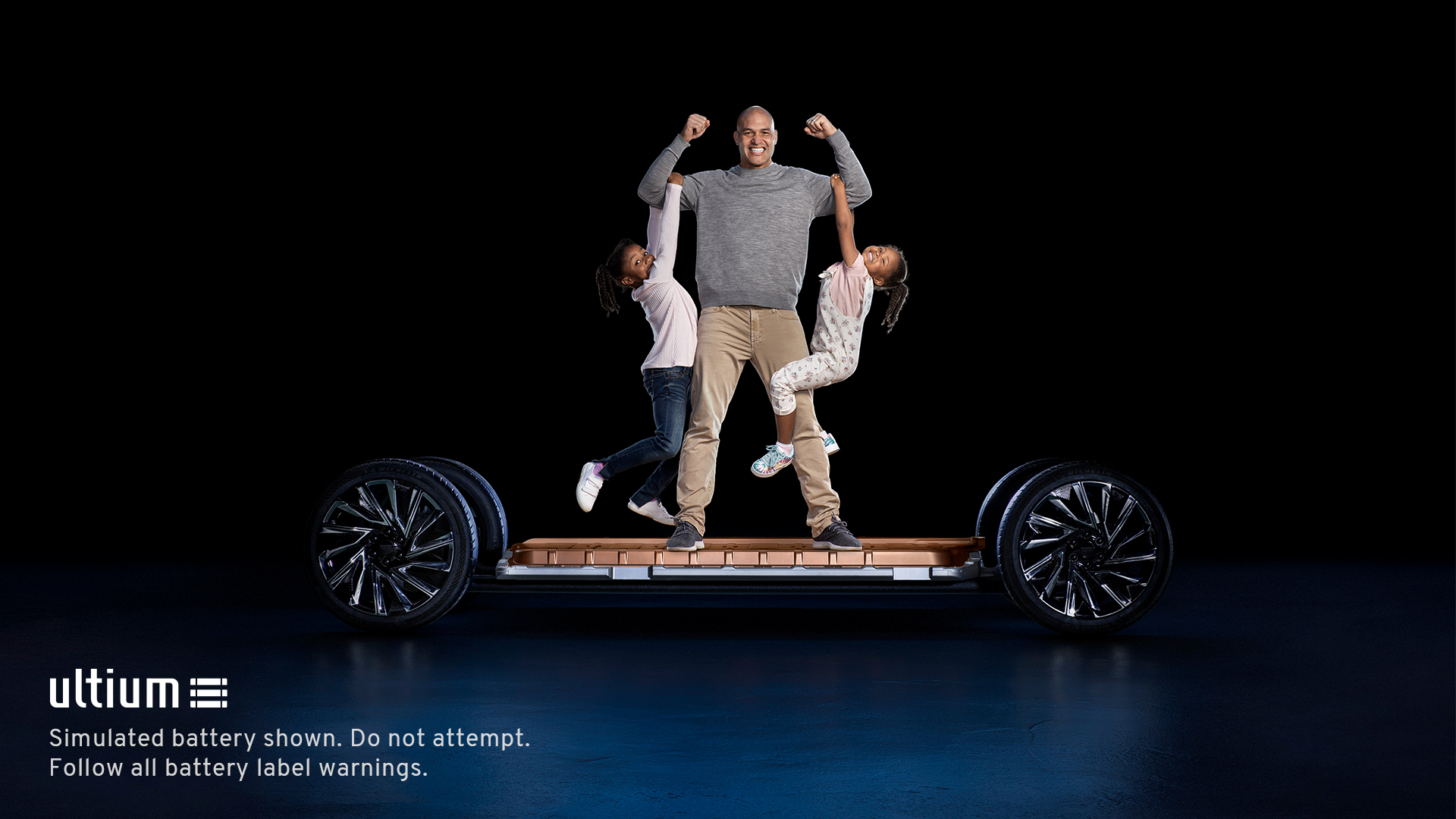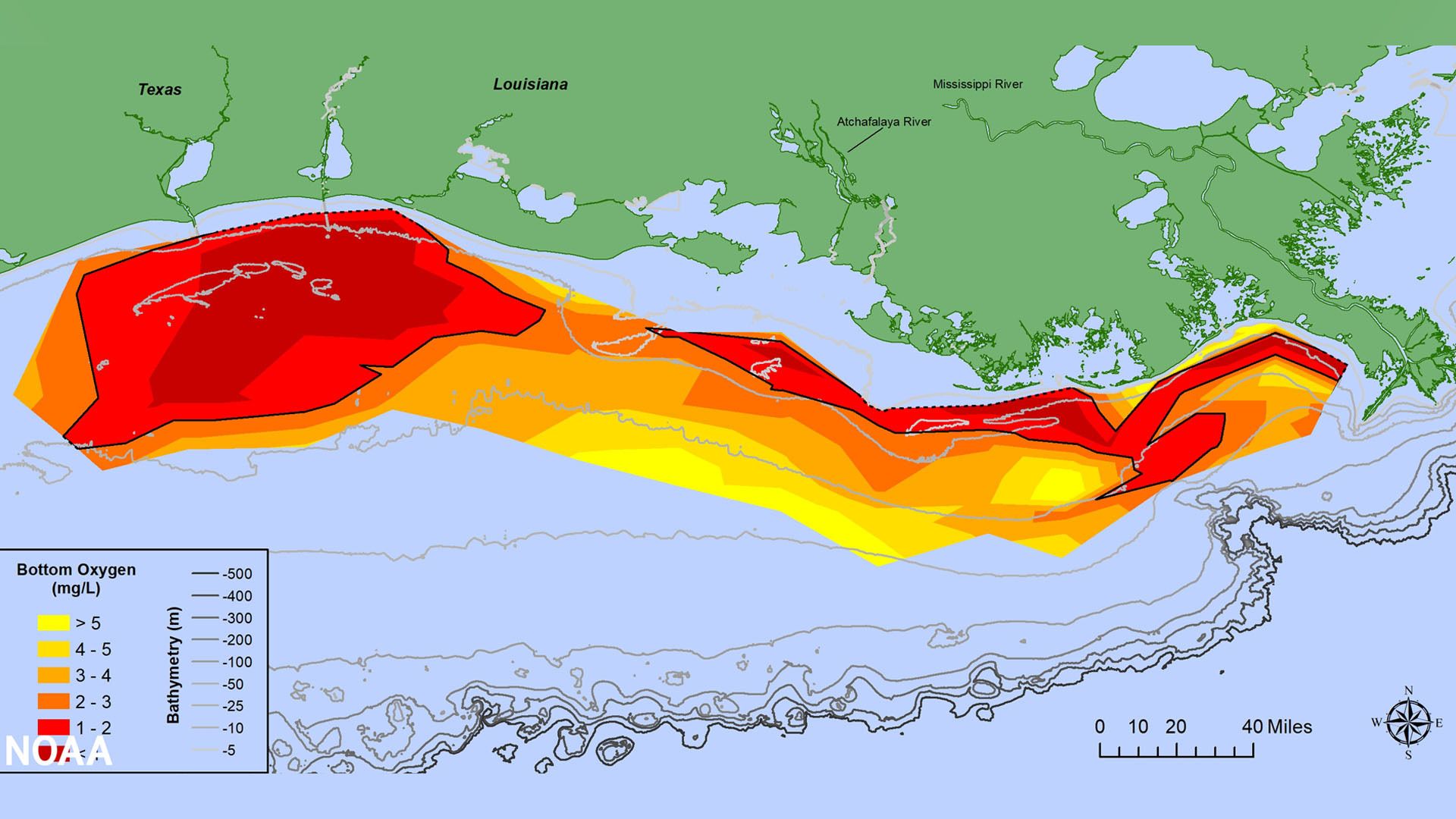| | | | | | | Presented By General Motors | | | | Axios What's Next | | By Bryan Walsh, Joann Muller and Erica Pandey ·Aug 04, 2021 | | It's Wednesday (right?), and we have sushi grown from cells, Delta's disruption of back-to-office plans and a very big dead zone. "What was next" trivia: On this day in 1916, what group of islands did the U.S. purchase from Denmark? Hint: It's the only place in the U.S. where traffic drives on the left. - Credit to reader Rich Hayes for being the first to note that Aaron Burr went on trial for treason on Aug. 3, 1807. At least he still has the best song in "Hamilton."
- Send your answer, along with tips and feedback, to whatsnext@axios.com.
Today's Smart Brevity™ count: 1,296 words ... 5 minutes. | | | | | | 1 big thing: Your future sushi dinner could be cultivated, not caught |  | | | Wild Type's cultivated salmon sashimi. Photo: Bryan Walsh/Axios | | | | Startups are getting close to being able to sell cultivated seafood products that have been grown from fish cells in a lab-like facility, rather than caught in the wild or farmed, Bryan Walsh writes. Why it matters: Developing cultivated animal protein that could compete with conventional products is a promising way for people to eat what they want without killing animals or damaging the planet. - But cultivated seafood could also help alleviate the conservation pressure on wild fish caused by overfishing.
What's happening: Last week I had the chance to try a few pieces of cultivated salmon sashimi and sushi from the startup Wildtype, which says it is close to being able to commercially produce salmon grown from fish cells in its San Francisco facility. - The verdict: I give it a solid B+ — not at the level of the best sushi I've ever had (that would be Sushi no Midori in Tokyo; high recommend, especially if you have a corporate expense account) — but much better than your average weekday takeout restaurant.
- In appearance, taste and mouthfeel, the cultivated salmon served to me was indistinguishable from fish that had been caught in the ocean or raised on a farm.
What they're saying: "This is sustainable seafood that is within reach," says Justin Kolbeck, Wildtype's co-founder and CEO. "And the long-term goal is to make it even cheaper than conventional salmon." How it works: Like other cultivated animal protein — which you may also know as "lab-grown," though the industry is trying to discourage the term — Wildtype's salmon started as a ball of cells harmlessly taken from a live fish egg. - And that's it for live fish in the process. "After we developed these cell lines, we haven't looked at a fish," says Wildtype co-founder Aryé Elfenbein.
- That was followed by years of scientific work to determine what mix of nutrients and environmental cues were needed to coax the base cells into the mix of muscle, fat and connective tissue a finished product needs.
- "The second part is creating a plant-based scaffold, essentially a mesh for the cells to grow within," says Elfenbein.
- The end result isn't a live fish but what looks like a block of edible salmon fillet.
The catch: Cultivated seafood — and cultivated animal protein more generally — hasn't yet been approved for commercial consumption, though Kolbeck says Wildtype is in "productive discussions" with the FDA. - Another barrier is price. Kolbeck estimates that it cost Wild Type about $25 to produce the eight pieces of sushi I ate. That's more than you'd pay for conventional fish, but Kolbeck expects the price to come down "significantly" as the company scales up.
Yes, but: Unlike cultivated beef or chicken — which have to compete with ultra-cheap conventional options — cultivated seafood faces a future where, thanks to overfishing and climate change, the price of much conventional seafood is likely "only going to increase," says Kolbeck. - That gives a conservation spin to cultivated seafood. While we're in no danger of running out of chickens or cattle — there are currently about 23 billion and 1.4 billion, respectively — global wild fish stocks are under severe pressure.
- "We're just at the very beginning of a story that will be the next gigantic level of the climate crisis," says Kolbeck. "It's just a downward slope for wild fish."
Read the rest |     | | | | | | 2. An e-scooter that drives like a motorcycle for city commuters |  | | | The sleek and simple Zapp i300 is designed for urban commuters. Photo: Zapp | | | | A new high-performance electric scooter is being billed as the transportation solution for urban residents who want an EV but don't have dedicated parking and can't exactly hang a charging cable out their apartment window, Joann Muller writes. What's happening: The $7,495 Zapp i300 is positioned as a daily commuter vehicle for urban dwellers — offering the convenience of a scooter and the performance of a motorcycle. Debuting this month in Paris, it's headed to Asia and the United States next year. The big picture: Powered, road-legal scooters are popular in many parts of the world, and the $109 billion global scooter market is transitioning to electric power at a faster rate than cars. - "Europeans and Asians continue to embrace this mode of personal urban mobility, and are adopting electric versions quickly. We hope savvy urban Americans will do so soon" said Swin Chatsuwan, founder and CEO of the British company.
Details: The simple but sleek i300 is fully recyclable, incorporating an original alloy exoskeleton and proprietary composite body, rather than plastic components. - The lightweight architecture — just 200 pounds — means it is easy to maneuver and goes 0 to 30 mph in just 2.3 seconds. For safety, the top speed is capped at 60 mph, and it comes with anti-lock brakes for quick stopping.
The battery may be the most novel feature: The i300 is equipped with two 1.4-kilowatt-hour, independent, portable battery packs, housed under the rider's feet, which provides improved stability. - The battery packs weigh 12 pounds each and are about the size of a laptop, and can be removed nightly for recharging in an ordinary domestic 110/240 volt outlet. Charging to 80% takes less than an hour.
- With both batteries on board, the scooter's range is 40 miles, but it can also operate on just one battery. That allows owners to leave one battery charging at home or in the office. Extra batteries are also available as accessories to swap out for longer trips.
Read the rest |     | | | | | | 3. Return-to-work plans keep getting foiled by the Delta variant |  | | | Illustration: Megan Robinson/Axios | | | | Companies that were eager to call employees back to the office are delaying those return dates as coronavirus infections keep rising, Erica Pandey writes. The big picture: The Delta variant is throwing us back into the thick of pandemic-era living, with new restrictions at restaurants and gyms and complications to return-to-work plans. Driving the news: J.P. Morgan is the latest firm to reconsider its return-to-work plans, Fox Business' Charles Gasparino reports. - And Morgan Stanley is sticking with its post-Labor Day return plan, but will enforce a daily health check and require employees to disclose whether or not they've been vaccinated, Gasparino notes.
Worth noting: The Wall Street firms have been among the most adamant that employees should stop teleworking and return to the office. A number of other companies — including Google, Indeed and Apple — are already pushing back return dates due to the Delta variant. - There's also a growing list of firms that are requiring employees to get vaccinated.
|     | | | | | | A message from General Motors | | An EV for everyone | | |  | | | | General Motors is adding 30 new electric vehicles and producing the revolutionary Ultium Platform. The background: This is made possible by a $35 billion investment in EVs and AVs through 2025 to make the all-electric future accessible for everyone. | | | | | | 4. Why the new space race is worth running |  | | | Illustration: Shoshana Gordon/Axios | | | | With billionaires in a new space race, Morgan Stanley estimates the global space industry could generate $1 trillion+ by 2040, up from roughly $350 billion now, Bryan writes. - Competition among commercial space companies, including SpaceX and Blue Origin, has helped bring down the cost of reaching low-Earth orbit by a factor of 20, according to NASA.
Reductions in launch costs have helped make it possible to cheaply put thousands of satellites into orbit, with the number projected to rise from 3,400 now to as many as 100,000 over the next decade. - Ardent proponents of space dream of asteroid mining and lunar manufacturing facilities. But the most immediate offshoots of the new space age will come in far cheaper satellite broadband internet access.
Read the rest |     | | | | | | 5. Number of the day: 6,334 sq. miles |  | | | Map of the Gulf of Mexico "dead zone." Image: Courtesy of NOAA | | | | That's the estimated size of the hypoxic "dead zone" in the Gulf of Mexico this summer, according to numbers released today by the National Oceanic and Atmospheric Administration, Bryan writes. How it works: The dead zone forms when excess nutrients — including fertilizer put on farm fields — in upland watersheds drain into the Gulf. - The nutrients stimulate massive algae growth, which eventually die, sink and decompose in the water.
- During that process, bacteria decay the algae, consuming oxygen in the process.
- Marine life can't survive the low oxygen levels, causing them to flee — which creates a dead zone.
By the numbers: At 6,334 sq. miles, this year's dead zone is bigger than Connecticut, and more than 17% bigger than the average hypoxic zone over the past five years. |     | | | | | | A message from General Motors | | An EV for everyone | | |  | | | | General Motors is adding 30 new electric vehicles and producing the revolutionary Ultium Platform. The background: This is made possible by a $35 billion investment in EVs and AVs through 2025 to make the all-electric future accessible for everyone. | | | | Thanks for reading! If this email was forwarded to you, subscribe here! |  | | It'll help you deliver employee communications more effectively. | | | | | | Axios thanks our partners for supporting our newsletters. If you're interested in advertising, learn more here.
Sponsorship has no influence on editorial content. Axios, 3100 Clarendon Blvd, Suite 1300, Arlington VA 22201 | | | You received this email because you signed up for newsletters from Axios.
Change your preferences or unsubscribe here. | | | Was this email forwarded to you?
Sign up now to get Axios in your inbox. | | | | Follow Axios on social media:    | | | | | |
No comments:
Post a Comment